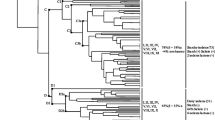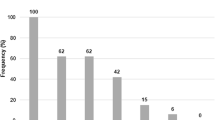Abstract
The major part (94%) of the Bacillus cereus-like isolates from a Danish sandy loam are psychrotolerant Bacillus weihenstephanensis according to their ability to grow at temperatures below 7 °C and/or two PCR-based methods, while the remaining 6% are B. cereus. The Bacillus mycoides-like isolates could also be␣divided into psychrotolerant and mesophilic isolates. The psychrotolerant isolates of B. mycoides could␣be discriminated from the mesophilic by the two PCR-based methods used to characterize B.␣weihenstephanensis. It is likely that the mesophilic B. mycoides strains are synonymous with Bacillus pseudomycoides, while psychrotolerant B. weihenstephanensis, like B. mycoides, are B. mycoides senso stricto. B. cereus is known to produce a number of factors, which are involved in its ability to cause gastrointestinal and somatic diseases. All the B. cereus-like and B. mycoides like isolates from the sandy loam were investigated by PCR for the presence of 12 genes encoding toxins. Genes for the enterotoxins (hemolysin BL and nonhemolytic enterotoxin) and the two of the enzymes (cereolysin AB) were present in the major part of the isolates, while genes for phospolipase C and hemolysin III were present in fewer isolates, especially among B. mycoides like isolates. Genes for cytotoxin K and the hemolysin II were only present in isolates affiliated to B. cereus. Most of the mesophilic B. mycoides isolates did not possess the genes for the nonhemolytic enterotoxin and the cereolysin AB. The presence of multiple genes coding for virulence factors in all the isolates from the B. cereus group suggests that all the isolates from the sandy loam are potential pathogens.
Similar content being viewed by others
References
Agata N., Ohta M., Mori M., Isobe M. (1995a). A novel dodecadepsipeptide, cereulide, is an emetic toxin of Bacillus cereus. FEMS Microbiol. Lett. 129:17–19
Agata N., Ohta M., Arakawa Y., Mori M. (1995b). The Bcet gene of Bacillus cereus encodes an enterotoxic protein. Microbiology 141:983–988, Part 4
Asano S., Nukumizu Y., Bando H., Iizuka T., Yamamoto T. (1997). Cloning of novel enterotoxin genes from Bacillus cereus and Bacillus thuringiensis: Appl. Environ. Microbiol. 63:1054–1057
Baida G.E., Kuzmin N.P. (1995). Cloning and primary structure of a new hemolysin gene from Bacillus-cereus. Biochim. Biophys. Acta 1264:151–154
Baida G., Budarina Z.I., Kuzmin N.P., Solonin A.S. (1999). Complete nucleotide sequence and molecular characterization of hemolysin II gene from Bacillus cereus. FEMS Microbiol. Lett. 180:7–14
Bavykin S.G., Lysov Y.P., Zakhariev V., Kelly J.J., Jackman J., Stahl D.A., Cherni A. (2004). Use of 16S rRNA, 23S rRNA, and gyrB gene sequence analysis to determine phylogenetic relationships of Bacillus cereus group microorganisms. J. Clin. Microbiol. 42:3711–3730
Bell J.A., Friedman S.B. (1994). Genetic-structure and diversity within local-populations of Bacillus mycoides. Evolution 48:1698–1714
Budarina Z.I., Sinev M.A., Mayorov S.G., Tomashevski A.Y., Shmelev I.V., Kuzmin N.P. (1994). Hemolysin-II is more characteristic of Bacillus thuringiensis than Bacillus cereus. Arch. Microbiol. 161:252–257
Cheun H.I., Makino S.I., Wataral M., Shirahata T., Uchida I., Takeshi K. (2001). A simple and sensitive detection system for Bacillus anthracis in meat and tissue. J. Appl. Microbiol. 91:421–426
Christiansson A., Bertilsson J., Svensson B. (1999). Bacillus cereus spores in raw milk: factors affecting the contamination of milk during the grazing period. J. Dairy Sci. 82:305–314
Damgaard P.H., Larsen H.D., Hansen B.W., Bresciani J., Jorgensen K. (1996). Enterotoxin-producing strains of Bacillus thuringiensis isolated from food. Lett. Appl. Microbiol. 23:146–150
Ehling-Schulz M., Fricker M., Scherer S. (2004). Bacillus cereus, the causative agent of an emetic type of food-borne illness. Mol. Nutr. Food Res. 48:479–487
Ehling-Schulz M., Vukov N., Schulz A., Shaheen R., Andersson M., Martlbauer E., Scherer S. (2005). Identification and partial characterization of the nonribosomal peptide synthetase gene responsible for cereulide production in emetic Bacillus cereus. Appl. Environ. Microbiol. 71:105–113
Farrar W.E. and Reboli A.C. 1991. The Genus Bacillus – Medical. The Prokaryotes, 2nd ed. Springer Verlag, New York, pp. 1746–1768
Francis K.P., Mayr R., von Stetten F., Stewart G.S.A.B., Scherer S. (1998). Discrimination of psychrotrophic and mesophilic strains of the Bacillus cereus group by PCR targeting of major cold shock protein genes. Appl. Environ. Microbiol. 64:3525–3529
Gilmore M.S., Cruzrodz A.L., Leimesterwachter M., Kreft J., Goebel W. (1989). A Bacillus-cereus cytolytic determinant, cereolysin-AB, which comprises the phospholipase-C and sphingomyelinase genes-nucleotide-sequence and genetic-linkage. J. Bacteriol. 171:744–753
Glare T. R. and O’Callaghan M. 2000. Bacillus thuringiensis: Biology, Ecology and Safety. John Wiley & Sons, Ltd
Granum P. E. 2001. Bacillus cereus. Food Microbiology: Fundamentals and Frontiers, 2nd. ed. ASM Press, pp. 373–381
Granum P.E., O’Sullivan K., Lund T. (1999). The sequence of the non-haemolytic enterotoxin operon from Bacillus cereus. FEMS Microbiol. Lett. 177:225–229
Guinebretiere M.H., Broussole V., Nguyen-The C. (2002). Enterotoxigenic profiles of food-poisoning and food-borne Bacillus cereus strains. J. Clin. Microbiol. 40:3053–3056
Hansen B.M., Hendriksen N.B. (1998). Bacillus thuringiensis and B. cereus toxins. IOBC Bull. 21(4):221–224
Hansen B.M., Hendriksen N.B. (2001). Detection of enterotoxic Bacillus cereus and Bacillus thuringiensis strains by PCR analysis. Appl. Environ. Microbiol. 67:185–189
Hansen B.M., Hoiby P.E., Jensen G.B., Hendriksen N.B. (2003). The Bacillus cereus bceT enterotoxin sequence reappraised. FEMS Microbiol. Lett. 223:21–24
Hansen B.M., Damgaard P.H., Eilenberg J., Pedersen J.C. (1998). Molecular and phenotypic characterization of Bacillus thuringiensis isolated from leaves and insects. J. Invert. Pathol. 71:106–114
Hansen B.M., Leser T.D., Hendriksen N.B. (2001). Polymerase chain reaction assay for the detections of Bacillus cereus group cells. FEMS Microbiol. Lett. 202:209–213
Harmon S.M. (1982). New method for differentiating members of the Bacillus-cereus group – collaborative study. J. Assoc. Off. Anal. Chem. 65:1134–1139
Heinrichs J.H., Beecher D.J., Macmillan J.D., Zilinskas B.A. (1993). Molecular-cloning and characterization of the HBLA gene encoding the B-component of hemolysin BL from Bacillus-cereus. J. Bacteriol. 175:6760–6766
Helgason E., Okstad O.A., Caugangt D.A., Johansen H.A., Fouet A., Mock M., Hegna I., Kolsto A.B. (2000). Bacillus anthracis, Bacillus cereus, and Bacillus thuringiensis - One species on the basis for genetic evidence. Appl. Environ. Microbiol. 66:2627–2630
Hoffmaster A.R., Ravel J., Rasko D.A., Chapman G.D., Chute M.D., Marston C.K., De B.K., Sacchi C.T., Fitzgerald C., Mayer L.W., Maiden M.C.J., Priest F.G., Barker M., Jiang L.X., Cer R.Z., Rilstone J., Peterson S.N., Weyant R.S., Galloway D.R., Read T.D., Popovic T., Fraser C.M. (2004). Identification of anthrax toxin genes in a Bacillus cereus associated with an illness resembling inhalation anthrax. PNAS 101:8449–8454
Hsieh Y.M., Sheu S.J., Chen Y.L., Tsen H.Y. (1999). Enterotoxigenic profiles and polymerase chain reaction detection of Bacillus cereus group cells and B-cereus strains from foods and food-borne outbreaks. J. Appl. Microbiol. 87:481–490
Ivanova N., Sorokin A., Anderson I., Galleron N., Candelon B., Kapatral V., Bhattacharyya A., Reznik G., Mikhailova N., Lapidus A., Chu L., Mazur M., Goltsman E., Larsen N., D’Souza M., Walunas T., Grechkin Y., Pusch G., Haselkorn R., Fonstein M., Ehrlich S.D., Overbeek R., Kyrpides N. (2003). Genome sequence of Bacillus cereus and comparative analysis with Bacillus anthracis. Nature 423:87–91
Jensen G.B., Hansen B.M., Eilenberg J., Mahillon J. (2003). The hidden lifestyles of Bacillus cereus and relatives. Environ. Microbiol. 5:631–640
Kuppe A., Evans L.M., McMillen D.A., Griffith O.H. (1989). Phosphatidylinositol-specific phospholipase-C of Bacillus-cereus – cloning, sequencing, and relationship to other phospholipases. J. Bacteriol. 171:6077–6083
Lechner M., Kupke T., Stefanovic S., Gotz F. (1989). Molecular characterization and sequence of phosphatidylinostitol-specific phospholipase C of Bacillus thuringiensis. Mol. Microbiol. 3:621–626
Lechner S., Mayr R., Francis K.P., Pruss B.M., Kaplan T., Wiessner-Gunkel E., Stewartz G.S.A.B., Scherer S. (1998). Bacillus weihenstephanensis sp nov is a new psychrotolerant species of the Bacillus cereus group. Int. J. Syst Bacteriol. 48:1373–1382
Lund T., De Buyser M.L., Granum P.E. (2000). A new cytotoxin from Bacillus cereus that may cause necrotic enteritis. Mol. Microbiol. 38:254–261
Mantynen V., Lindstrom K. (1998). A rapid PCR-based DNA test for enterotoxic Bacillus cereus. Appl. Environ. Microbiol. 64:1634–1639
Margulis L., Jorgensen J.Z., Dolan S., Kolchinsky R., Rainey F.A., Lo S.C. (1998). The Arthromitus stage of Bacillus cereus: intestinal symbionts of animals. PNAS 95:1236–1241
Miles G., Bayley H., Cheley S. (2002). Properties of Bacillus cereus hemolysin II: A heptameric transmembrane pore. Protein Sci. 11:1813–1824
Nakamura L.K. (1998). Bacillus pseudomycoides sp. nov. Int. J. Syst. Bacteriol. 48:1031–1035
Nakamura L.K., Jackson M.A. (1995). Clarification of the taxonomy of Bacillus mycoides. Int. J. Syst. Bacteriol. 45:46–49
Pepper I.L., Gentry T.J. (2002). Incidence of Bacillus anthracis in soil. Soil Sci. 167:627–635
Pruss B.M., Francis K.P., von Stetten F., Scherer S. (1999a). Correlation of 16S ribosomal DNA signature sequences with temperature-dependent growth rates of mesophilic and psyshrotolerant strains of the Bacillus cereus group. J. Bact. 181:2624–2630
Pruss B.M., Dietrich R., Nibler B., Martlbauer E., Scherer S. (1999b). The hemolytic enterotoxin HBL is broadly distributed among species of the Bacillus cereus group. Appl. Environ. Microbiol. 65:5436–5442
Rasko D.A., Ravel J., Okstad O.A., Helgason E., Cer R.Z., Jiang L.X., Shores K.A., Fouts D.E., Tourasse N.J., Angiuoli S.V., Kolonay J., Nelson W.C., Kojsto A.B., Fraser C.M., Read T.D. (2004). The genome sequence of Bacillus cereus ATCC 10987 reveals metabolic adaptations and a large plasmid related to Bacillus anthracis pX01. NAR 32:977–988
Ryan P.A, Macmillan J.D., Zilinskas B.A. (1997). Molecular cloning and characterization of the genes encoding the L(1) and L(2) components of hemolysin BL from Bacillus cereus. J. Bacteriol. 179:2551–2556
Stenfors L.P., Granum P.E. (2001). Psychrotolerant species from the Bacillus cereus group are not necessarily Bacillus weihenstephanensis. FEMS Microbiol. Lett. 197:223–228
Stenfors L.P., Mayr R., Scherer S., Granum P.E. (2002). Pathogenic potential of fifty Bacillus weihenstephaninsis strains. FEMS Microbiol. Lett. 215:47–51
Tegiffel M.C., Beumer R.R., Slaghuis B.A., Rombouts F.M. (1995). Occurrence and characterization of (Psychrotrophic) Bacillus-cereus on farms in the Netherlands. Neth. Milk Dairy J. 49:125–138
Travers R.S., Martin P.A.W., Reichelderfer C.F. (1987). Selective process for efficient isolation of soil Bacillus spp. Appl. Environ. Microbiol. 53:1263–1266
Vilas-Boas G., Sanchis V., Lereclus D., Lemos M.V.F., Bourguet D. (2002). Genetic differentiation between sympatric populations of Bacillus cereus and Bacillus thuringiensis. Appl. Environ. Microbiol. 68:1414–1424
von Stetten F, Francis K.P., Lechner S., Neuhaus K., Scherer S. (1998). Rapid discrimination of psychrotolerant and mesophilic strains of the Bacillus cereus group by PCR targeting of 16S rDNA. J. Microbiol. Methods 34:99–106
von Stetten F., Mayr R., Scherer S. (1999). Climatic influence on mesophilic Bacillus cereus and psychrotolerant Bacillus weihenstephanensis populations in tropical, temperate and alpine soil. Environ. Microbiol. 1:503–515
Willumsen P.A., Johansen J.E., Karlson U., Hansen B.M. (2005). Isolation and taxonomic affiliation of N-heterocyclic aromatic hydrocarbon-transforming bacteria. Appl. Microbiol. Biotechnol. 67:420–428
Acknowledgements
The project was supported by a grant from the Danish Ministry of Food, Agriculture and Fishery (FØS100-DMU-5). We thank Bente R. Hansen and Lillian F. Larsen for excellent technical assistance.
Author information
Authors and Affiliations
Corresponding author
Rights and permissions
About this article
Cite this article
Hendriksen, N.B., Hansen, B.M. & Johansen, J.E. Occurrence and pathogenic potential of Bacillus cereus group bacteria in a sandy loam. Antonie Van Leeuwenhoek 89, 239–249 (2006). https://doi.org/10.1007/s10482-005-9025-y
Received:
Accepted:
Published:
Issue Date:
DOI: https://doi.org/10.1007/s10482-005-9025-y




